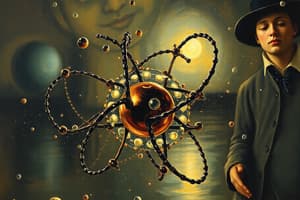Podcast
Questions and Answers
What is an atom?
What is an atom?
- A subatomic particle with a negative charge.
- The simplest form of a pure substance.
- The basic particle from which all elements are made. (correct)
- The positively charged dense center of an atom.
What defines an element?
What defines an element?
The simplest form of a pure substance.
What does the nucleus of an atom contain?
What does the nucleus of an atom contain?
Neutrons and protons.
What is an electron?
What is an electron?
What is a neutron?
What is a neutron?
What is a proton?
What is a proton?
What is atomic number?
What is atomic number?
What is mass number?
What is mass number?
What is atomic mass?
What is atomic mass?
What is an isotope?
What is an isotope?
What is an ion?
What is an ion?
What is an energy level?
What is an energy level?
What are valence electrons?
What are valence electrons?
What equals atomic number?
What equals atomic number?
What equals the number of electrons?
What equals the number of electrons?
What equals number of protons + number of neutrons?
What equals number of protons + number of neutrons?
What equals atomic mass - number of protons?
What equals atomic mass - number of protons?
Flashcards are hidden until you start studying
Study Notes
Basic Concepts of Atoms
- An atom is the fundamental unit of matter, composed of a nucleus surrounded by electrons.
- An element represents the simplest form of pure substances, distinguished by unique properties.
Structure of an Atom
- The nucleus is the central region of an atom, composed of positively charged protons and neutral neutrons.
- Electrons are negatively charged subatomic particles that orbit the nucleus.
Subatomic Particles
- Neutrons have no charge and reside within the nucleus, contributing to the atom's mass.
- Protons are positively charged and define an element's atomic number.
Key Atomic Properties
- Atomic number indicates the number of protons in the nucleus, crucial for identifying elements.
- Mass number is the total count of protons and neutrons in an atom's nucleus, reflecting its overall mass.
- Atomic mass is the weighted average mass of an element’s isotopes, considering their relative abundance.
Isotopes and Ions
- An isotope differs in neutron count while maintaining the same number of protons and electrons.
- An ion is formed when an atom gains or loses electrons, resulting in a charge.
Electron Configuration
- Energy levels represent the energy state of electrons; those closer to the nucleus have higher energy.
- Valence electrons are the electrons located in the outermost energy level, playing a key role in chemical bonding.
Relationships Among Atomic Properties
- The number of protons equals the atomic number and the number of electrons in a neutral atom.
- The atomic mass can be calculated by adding the number of protons and neutrons.
- The number of neutrons can be determined by subtracting the number of protons from the atomic mass.
Studying That Suits You
Use AI to generate personalized quizzes and flashcards to suit your learning preferences.




